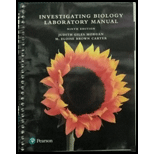
Concept explainers
How did Stanley Miller's experiments support the idea that, even at life's origins, physical and chemical laws govern the processes of life?
To review: Miller’s experiment formed the basis of the idea that origin of life and its processes are governed by physical and chemical laws.
Introduction: In 1953, Stanley Miller set up an experiment with conditions resembling those present on the early Earth. The possibility of organic compound formation was investigated under simulated conditions. He used a mixture of gases such as hydrogen, methane, ammonia, and water vapor in his experiment and passed sparks through the mixture of gases. After reactions, a number of compounds were identified in the mixture and many of them were organic compounds.
Explanation of Solution
Miller synthesized many organic compounds in his abiotic experiment by simulating the chemical and physical conditions that were present in the early Earth before the starting of life. . Abiotic experiments are those that do not involve in any material derived from living organisms. Miller’s experiment involved only physical and chemical phenomenon. Water was kept in a flask and was heated. The vapor generated was passed through a mixture of gases and sparks were generated to mimic lightning. A condenser was used to cool the hot gases and collected for analysis. These chemical and physical processes led to the formation of organic compounds that are commonly found in living organisms. Before Miller’s experiment, organic compounds were thought to be formed only by living organisms and life was believed to be a phenomenon not governed by physical and chemical sciences.
Miller’s experiment showed that life might have originated under abiotic conditions present in the early Earth. This discovery led to the conclusion that physical and chemical laws played an important role in the origin of life and are essential in life processes.
Want to see more full solutions like this?
Chapter 4 Solutions
Investigating Biology Laboratory Manual (9th Edition)
Additional Science Textbook Solutions
Laboratory Manual For Human Anatomy & Physiology
Campbell Essential Biology (7th Edition)
Microbiology Fundamentals: A Clinical Approach
Human Physiology: An Integrated Approach (8th Edition)
Physics for Scientists and Engineers: A Strategic Approach, Vol. 1 (Chs 1-21) (4th Edition)
- 18. Watch this short youtube video about SARS CoV-2 replication. SARS-CoV-2 Life Cycle (Summer 2020) - YouTube.19. What is the name of the receptor that SARS CoV-2 uses to enter cells? Which human cells express this receptor? 20. Name a few of the proteins that the SARS CoV-2 mRNA codes for. 21. What is the role of the golgi apparatus related to SARS CoV-2arrow_forwardState the five functions of Globular Proteins, and give an example of a protein for each function.arrow_forwardDiagram of check cell under low power and high powerarrow_forward
- a couple in which the father has the a blood type and the mother has the o blood type produce an offspring with the o blood type, how does this happen? how could two functionally O parents produce an offspring that has the a blood type?arrow_forwardWhat is the opening indicated by the pointer? (leaf x.s.) stomate guard cell lenticel intercellular space none of thesearrow_forwardIdentify the indicated tissue? (stem x.s.) parenchyma collenchyma sclerenchyma ○ xylem ○ phloem none of thesearrow_forward
- Where did this structure originate from? (Salix branch root) epidermis cortex endodermis pericycle vascular cylinderarrow_forwardIdentify the indicated tissue. (Tilia stem x.s.) parenchyma collenchyma sclerenchyma xylem phloem none of thesearrow_forwardIdentify the indicated structure. (Cucurbita stem l.s.) pit lenticel stomate tendril none of thesearrow_forward
- Identify the specific cell? (Zebrina leaf peel) vessel element sieve element companion cell tracheid guard cell subsidiary cell none of thesearrow_forwardWhat type of cells flank the opening on either side? (leaf x.s.) vessel elements sieve elements companion cells tracheids guard cells none of thesearrow_forwardWhat specific cell is indicated. (Cucurbita stem I.s.) vessel element sieve element O companion cell tracheid guard cell none of thesearrow_forward
 Biology (MindTap Course List)BiologyISBN:9781337392938Author:Eldra Solomon, Charles Martin, Diana W. Martin, Linda R. BergPublisher:Cengage Learning
Biology (MindTap Course List)BiologyISBN:9781337392938Author:Eldra Solomon, Charles Martin, Diana W. Martin, Linda R. BergPublisher:Cengage Learning Human Heredity: Principles and Issues (MindTap Co...BiologyISBN:9781305251052Author:Michael CummingsPublisher:Cengage Learning
Human Heredity: Principles and Issues (MindTap Co...BiologyISBN:9781305251052Author:Michael CummingsPublisher:Cengage Learning Human Biology (MindTap Course List)BiologyISBN:9781305112100Author:Cecie Starr, Beverly McMillanPublisher:Cengage Learning
Human Biology (MindTap Course List)BiologyISBN:9781305112100Author:Cecie Starr, Beverly McMillanPublisher:Cengage Learning Concepts of BiologyBiologyISBN:9781938168116Author:Samantha Fowler, Rebecca Roush, James WisePublisher:OpenStax College
Concepts of BiologyBiologyISBN:9781938168116Author:Samantha Fowler, Rebecca Roush, James WisePublisher:OpenStax College
 Principles Of Radiographic Imaging: An Art And A ...Health & NutritionISBN:9781337711067Author:Richard R. Carlton, Arlene M. Adler, Vesna BalacPublisher:Cengage Learning
Principles Of Radiographic Imaging: An Art And A ...Health & NutritionISBN:9781337711067Author:Richard R. Carlton, Arlene M. Adler, Vesna BalacPublisher:Cengage Learning





